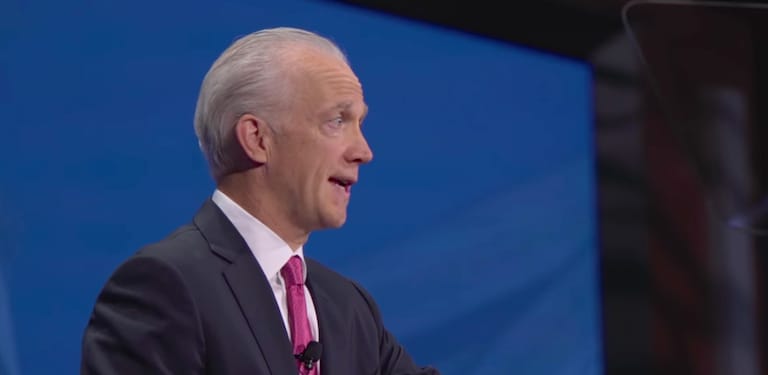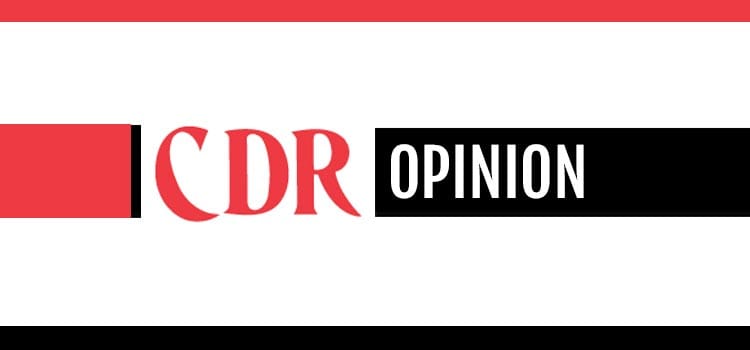
NACDS chairman Martin Otto speaks to Total Store Expo attendees during the show’s business program.
The NACDS Total Store Expo in Boston last month has several claims to distinction.
In its fourth year, the event — which brings together aspects of the industry that the association previously addressed in three separate shows — hit its stride in terms of fostering interaction between retailers and suppliers, with the Meet the Market and Meet the Retailer programs complementing activity in the exhibit hall, which housed representatives of 741 pharmaceutical, front-end and technology companies.
TSE attendees benefited from a series of informative Insight Sessions that covered a range of timely issues, everything from omnichannel retailing’s impact on the supply chain and community-based point-of-care health screenings to collaboration between trading partners on product launches and the digital revolution.
At Vision 2027, a special section of the show floor, exhibitors examined the future of retailing and collaboration among business partners. Even the entertainment — Steven Tyler of Aerosmith — was first rate.

For this observer, the highlight of TSE occurred at the business program, where NACDS chairman Martin Otto and Steve Anderson, the organization’s president and chief executive officer, talked about the state of the U.S. health care system, its impact on other national priorities, and the road ahead for community pharmacies.
In his introduction of Otto, Anderson called him “our challenger in chief.” The H-E-B executive, who is chief merchant and chief financial officer at the food/drug retailer, did not disappoint.
Otto gave the audience a deeply researched, carefully thought-out overview of health care in America, where an extraordinary level of spending is producing very ordinary results, and the size of the investment leaves other important social programs starved for funding. Drawing on an impressive array of sources, he documented the disconnect between U.S. health care expenditures — which stand at 18% or 19% of GDP, compared to 8% to 11% in other advanced countries such as Germany and Finland — and patient outcomes.
“Americans are spending a lot of money on health care, and we have to ask whether we are getting our money’s worth. The answer is no,” Otto said, citing the U.S.’ poor performance in life expectancy and infant mortality. The reasons behind America’s troubling record are many, but Otto boiled them down to three categories — poor individual health knowledge and behavior; limited patient access to and time with providers; and inherent structural problems.
While the cogent analysis was sobering, Otto asserted his belief that the issues can be addressed. “Each health care issue can be broken down and solved.
“However, we have to have the will to do that, and our political leadership has to take action to make these things happen. We, as corporations, can and should do some of this, but the issue is beyond just us.”
Otto went on to assess the negative effect excessive health care costs have on education and social services, exacerbating the plight of the 39% of the U.S. population who live at or near the poverty line. That, in turn, creates a vicious cycle and leads to additional health care expenditures.
“Resources are limited, which means we have to determine how to reallocate the money in a wiser way so that we achieve the outcomes that we want without overspending,” he said. “We need to look at the system as a whole in order to fix these issues, and we as an organization and individual companies can play a critical role.”
Otto’s presentation represented a further expansion of NACDS’ vision over the past decade from a relatively narrow focus on pharmacy-related issues to the entire health care system and now society as a whole, as well as expressing confidence in the membership’s ability to make a difference.
Anderson echoed those themes. Characterizing trade associations as entities that sit at “the nexus of where business, policy and politics come together,” he asserted that the chain pharmacy industry can have a profound effect on improving people’s lives.
“NACDS is helping to put the public back into public policy,” Anderson said. “NACDS is putting patients at the center of patient care. NACDS is keeping the membership at the heart of member services. NACDS is injecting the pharmacy electorate into critical elections. And the NACDS Foundation and our partners are focusing on the public in public health initiatives.”
As Otto and Anderson made abundantly clear, the association and its members are stepping up to an enlarged set of responsibilities as health care providers, businesses and citizens. That bodes well for the industry, the people it serves and the country.







